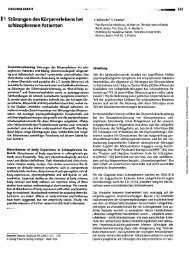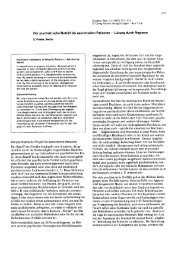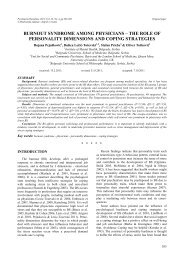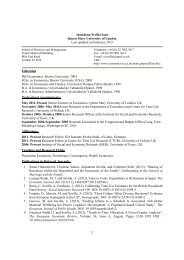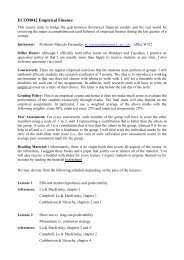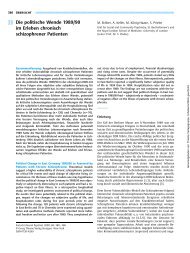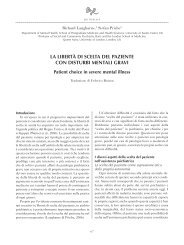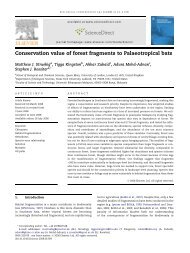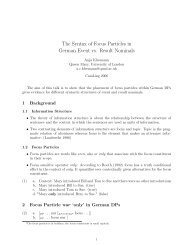Proofs - Personal Webspace for QMUL - Queen Mary, University of ...
Proofs - Personal Webspace for QMUL - Queen Mary, University of ...
Proofs - Personal Webspace for QMUL - Queen Mary, University of ...
Create successful ePaper yourself
Turn your PDF publications into a flip-book with our unique Google optimized e-Paper software.
S40 A. Heinz et al. / European Psychiatry 27 (2012) / supplement n°2 / S32-S43<br />
the oldest brother <strong>of</strong> the spouse possesses the highest authority.<br />
Children thus have to get along with potential confl icts between<br />
the loyalty to their father and to the brother <strong>of</strong> their mother, just<br />
as wives have to bridge the potential gap between the interests<br />
<strong>of</strong> their husbands and their relatives on their mother’s side [43].<br />
These confl icts are refl ected in the Ashanti concept <strong>of</strong> a person.<br />
According to the traditional concept, a person consists <strong>of</strong> “Okra”,<br />
the soul and the seed <strong>of</strong> vitality, which is understood (in a way<br />
that resembles Aristoteles’concepts) as the functional principle<br />
<strong>of</strong> a person. Among the Ashanti, “Okra” is understood in a non<br />
dualistic way as composed <strong>of</strong> both material and spiritual parts.<br />
It is given to a human being by the highest god in the moment<br />
<strong>of</strong> birth, and as a soul or principal <strong>of</strong> life, it can be reincarnated<br />
in different bodies. “Sunsum”, on the other hand, is the spiritual<br />
aspect <strong>of</strong> a person, which is received from the father. As an active<br />
principle, “Sunsum” is associated with personality traits and the<br />
moral behaviour and character <strong>of</strong> a person. “Sunsum” can leave<br />
the body during sleep and can be damaged by (black) magic.<br />
“Ntoro” is sometimes used synonymous with “sunsum” and<br />
directly refers the origin <strong>of</strong> the personal character, the semen <strong>of</strong><br />
the father, which is the source <strong>of</strong> individual desires and hence<br />
potentially “anti- social”, while “Mogya”, the blood, is derived<br />
from the mother and controls social con<strong>for</strong>mity to the family<br />
and clan with which the blood is shared. After a person’s death,<br />
“Mogya” turns into a spirit that retains the physical <strong>for</strong>m <strong>of</strong> the<br />
person. This latter idea illustrates that “Mogya” – like all other<br />
Ashanti concepts – includes spiritual and material aspects and<br />
that the dualism commonly known in the Western tradition<br />
cannot usefully be applied to these West African concepts [43].<br />
In Jamaica, traditional believes also hold that clan cohesion<br />
is guaranteed by the common “blood” shared in the kinship [56].<br />
This similarity <strong>of</strong> concepts could be more than a coincidence,<br />
since it is assumed that about half <strong>of</strong> all African slaves abducted<br />
to Jamaica were Ashanti. This may be due to the fact that West<br />
Africans reacted quite differently when <strong>for</strong>ced into slavery,<br />
depending – among other factors – on whether they grew up<br />
in regions with strong collectivistic traits or in slave holding<br />
societies. The Ashanti kingdom was such a slave holding society,<br />
which was <strong>for</strong>med during centuries <strong>of</strong> hunting <strong>for</strong> and trading<br />
<strong>of</strong> slaves. Subjected to regular slave hunts, African societies<br />
were thus trans<strong>for</strong>med into states that themselves specialised<br />
in slave trade, particularly when located in coasty areas [41].<br />
West Africans coming from inland regions with predominant<br />
village structures and rather strong ties to their neighbours <strong>of</strong>ten<br />
starved themselves to death on board <strong>of</strong> the slave ships or even<br />
committed suicide. The Ashanti, on the other hand, were well<br />
acquainted with slavery and there<strong>for</strong>e <strong>of</strong>ten employed as supervisors<br />
<strong>of</strong> plantations in the Caribbeans. However, riots were so<br />
<strong>of</strong>ten started by Ashanti that most Western European states did<br />
not allow any further import <strong>of</strong> Ashanti into their colonies; only<br />
the British Empire continued to abduct Ashanti and ship them<br />
to Jamaica, an island conquered in the 17th century from Spain.<br />
Here, African slaves that escaped to the mountains (“Maroons”)<br />
founded free villages and fought two wars against British colonial<br />
authorities, thus achieving a limited degree <strong>of</strong> self- rule [41,4].<br />
Would this mean that we should distinguish between 1) West<br />
African concepts <strong>of</strong> a person, which are developed within a<br />
village community and constitute a “collective ego” on the one<br />
hand, and 2) an “individual ego” on the other hand, which arises<br />
in Westernized slaveholding societies? The answer is no, because<br />
concepts such as the “collective ego” and the “individual ego”<br />
are rather crude simplifi cations, which do not give adequate<br />
consideration to culturally complex differences in the respective<br />
concepts <strong>of</strong> a person.<br />
For example, the Tallensi, a population living in Northern<br />
Ghana, developed a concept <strong>of</strong> the person, that differs strongly<br />
from the concept established among the Ashanti in Southern<br />
Ghana, even though both populations live in the same state [43].<br />
The Tallensi assume that all living beings are composed <strong>of</strong> a body<br />
and the breath. Human beings also process a soul (“Sii”), which<br />
differs from the breath. This soul can leave the body during sleep<br />
(a concept also found among the Ashanti) and appear in the<br />
dream <strong>of</strong> another person. The Tallensi also assume that there is a<br />
self (“Meng”), which is closely linked with the soul. However, the<br />
status <strong>of</strong> a “full person” is only acquired in a livelong, stepwise<br />
process, which is associated with the (increasing) social status<br />
<strong>of</strong> the individual: only a male person, who represents a social<br />
authority (an elder) in a social group and who has male children,<br />
possesses the full status <strong>of</strong> a “person”. After death, such a person<br />
becomes an ancestor, who is religiously venerated and who can<br />
interfere with the fate <strong>of</strong> living human beings. Whenever a child<br />
is born, the group <strong>of</strong> ancestors who protects the child will also<br />
control its future fate. Ancestors thus become protectors <strong>of</strong> tradition.<br />
In this concept, the focus <strong>of</strong> attention is directed towards<br />
the collective ancestry <strong>of</strong> the population, however, the individual<br />
status <strong>of</strong> any human being is determined by his own children<br />
and the individual social status he acquired. There<strong>for</strong>e, the<br />
anthropologist Morris repeatedly cautions against reductionist<br />
and simplifying concepts such as the idea that an individualistic<br />
tradition in Europe can be juxtaposed to a collectivist tradition<br />
in Africa – instead, Morris emphasises that each culture balances<br />
mechanisms and concepts, which mediate between individuals<br />
and society and their respective desires and demands [43].<br />
<strong>Pro<strong>of</strong>s</strong><br />
10. The self in neuroscience<br />
Recently, the construction <strong>of</strong> the self has also been studied in<br />
neuroscience. Similar to some contemporary philosophers, such<br />
as Thomas Metzinger [42], neuroscientifi c approaches to the<br />
self assume that the self is not an entity outside or independent<br />
<strong>of</strong> the brain, but rather an entity that is realized in the brain.<br />
The assumption is that the self is a model created by the brain.<br />
According to this assumption, how is the brain creating the<br />
self? Most neuroscientifi c theories refrain from the idea that<br />
“the self” is processed in a particular brain area which would<br />
serve as a homunculus- like observer <strong>of</strong> processes going on in<br />
other parts <strong>of</strong> the brain. Such a model would, again, raise the<br />
problem <strong>of</strong> the infi nite regress: which brain region is “observing”<br />
the observer- region? Instead, most theories favour the<br />
idea that “the self” as a complex phenomenon is emerging from<br />
the interplay between several brain areas, which function as a<br />
kind <strong>of</strong> self- network; each brain area might subserve a specifi c<br />
aspect <strong>of</strong> self- related in<strong>for</strong>mation processing and the interaction<br />
between these neuronal networks thus constitutes our experience<br />
<strong>of</strong> a phenomenological self. According to a model proposed<br />
by North<strong>of</strong>f and Bermpohl [45], self- referential processing in<br />
cortical midline structures is a fundamental component in




